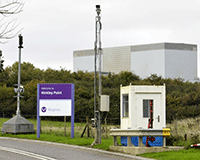 The Supreme Court has refused permission to appeal to the Irish National Trust in its challenge to the energy secretary’s decision to grant development consent for the Hinkley Point C nuclear power station in Somerset without consulting Ireland.
The Supreme Court has refused permission to appeal to the Irish National Trust in its challenge to the energy secretary’s decision to grant development consent for the Hinkley Point C nuclear power station in Somerset without consulting Ireland.
In 2013, Patterson J dismissed An Taisce’s challenge to the March 2013 decision, and, last year, the Court of Appeal rejected its claim that the secretary of state failed to comply with his obligation to undertake transboundary consultation, as required by the European Commission’s Environmental Impact Assessment Directive.
An Taisce claimed that he misconstrued the meaning of “likely significant environmental effects” in granting permission for the European pressurised reactor nuclear power station. It argued that the case, which raised issues regarding the need for transboundary consultation on the environmental effects of developments on neighbouring EU member states, should be referred to the Court of Justice of the European Union to provide a “definitive” meaning of the likelihood of nuclear disaster for the purposes of the Environmental Impact Directive.
However, the decision will now stand after Lords Kerr, Carnwath and Hodge refused An Taisce permission to appeal.
Their decision states: “Permission to appeal be refused because the application does not raise an arguable point of law of general public importance which ought to be considered by the Supreme Court at this time bearing in mind that the case has already been the subject of judicial decision and reviewed on appeal.”
In the Court of Appeal decision, Sullivan LJ said: “In the present case, it is common ground that the probability of a severe nuclear accident is very low indeed. There may be an issue as to just how low that probability is, but there is no doubt that the defendant was entitled to describe it in his decision as a ‘very low probability’.
“The issue, therefore, is whether the risk of a significant effect on the environment can properly be excluded on the basis of a very low probability, or only upon the basis of a zero probability.
“In the context of very many, if not most, of the projects listed in the Directive, it is difficult to see how it could seriously be contended that a significant effect on the environment which would not be expected to occur more frequently than once in every 10 million years could not properly be excluded from environmental impact assessment on the basis of objective information.”
Energy company NNB Generation has already out expensive earthworks at the site.
R (on the application of An Taisce, The National Trust for Ireland) v Secretary of State for Energy and Climate Change and another Supreme Court (Lords Kerr, Carnwath and Hodge) 15 January 2015








